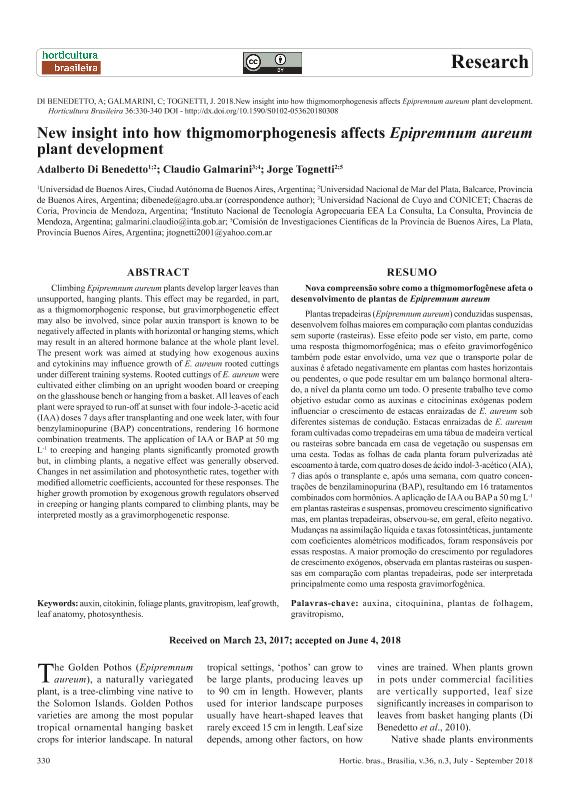Mostrar el registro sencillo del ítem
dc.contributor.author
Di Benedetto, Adalberto Hugo

dc.contributor.author
Galmarini, Claudio Romulo

dc.contributor.author
Tognetti, Jorge Alberto

dc.date.available
2020-04-06T19:29:17Z
dc.date.issued
2018-09
dc.identifier.citation
Di Benedetto, Adalberto Hugo; Galmarini, Claudio Romulo; Tognetti, Jorge Alberto; New insight into how thigmomorphogenesis affects Epipremnum aureum plant development; Associação Brasileira de Horticultura; Horticultura Brasileira; 36; 3; 9-2018; 330-340
dc.identifier.issn
0102-0536
dc.identifier.uri
http://hdl.handle.net/11336/102066
dc.description.abstract
Climbing Epipremnum aureum plants develop larger leaves than unsupported, hanging plants. This effect may be regarded, in part, as a thigmomorphogenic response, but gravimorphogenetic effect may also be involved, since polar auxin transport is known to be negatively affected in plants with horizontal or hanging stems, which may result in an altered hormone balance at the whole plant level. The present work was aimed at studying how exogenous auxins and cytokinins may influence growth of E. aureum rooted cuttings under different training systems. Rooted cuttings of E. aureum were cultivated either climbing on an upright wooden board or creeping on the glasshouse bench or hanging from a basket. All leaves of each plant were sprayed to run-off at sunset with four indole-3-acetic acid (IAA) doses 7 days after transplanting and one week later, with four benzylaminopurine (BAP) concentrations, rendering 16 hormone combination treatments. The application of IAA or BAP at 50 mg L-1 to creeping and hanging plants significantly promoted growth but, in climbing plants, a negative effect was generally observed. Changes in net assimilation and photosynthetic rates, together with modified allometric coefficients, accounted for these responses. The higher growth promotion by exogenous growth regulators observed in creeping or hanging plants compared to climbing plants, may be interpreted mostly as a gravimorphogenetic response.
dc.description.abstract
Plantas trepadeiras (Epipremnum aureum) conduzidas suspensas, desenvolvem folhas maiores em comparação com plantas conduzidas sem suporte (rasteiras). Esse efeito pode ser visto, em parte, como uma resposta thigmomorfogênica; mas o efeito gravimorfogênico também pode estar envolvido, uma vez que o transporte polar de auxinas é afetado negativamente em plantas com hastes horizontais ou pendentes, o que pode resultar em um balanço hormonal alterado, a nível da planta como um todo. O presente trabalho teve como objetivo estudar como as auxinas e citocininas exógenas podem influenciar o crescimento de estacas enraizadas de E. aureum sob diferentes sistemas de condução. Estacas enraizadas de E. aureum foram cultivadas como trepadeiras em uma tábua de madeira vertical ou rasteiras sobre bancada em casa de vegetação ou suspensas em uma cesta. Todas as folhas de cada planta foram pulverizadas até escoamento à tarde, com quatro doses de ácido indol-3-acético (AIA), 7 dias após o transplante e, após uma semana, com quatro concentrações de benzilaminopurina (BAP), resultando em 16 tratamentos combinados com hormônios. A aplicação de IAA ou BAP a 50 mg L-1 em plantas rasteiras e suspensas, promoveu crescimento significativo mas, em plantas trepadeiras, observou-se, em geral, efeito negativo. Mudanças na assimilação líquida e taxas fotossintéticas, juntamente com coeficientes alométricos modificados, foram responsáveis por essas respostas. A maior promoção do crescimento por reguladores de crescimento exógenos, observada em plantas rasteiras ou suspensas em comparação com plantas trepadeiras, pode ser interpretada principalmente como uma resposta gravimorfogênica.
dc.format
application/pdf
dc.language.iso
eng
dc.publisher
Associação Brasileira de Horticultura

dc.rights
info:eu-repo/semantics/openAccess
dc.rights.uri
https://creativecommons.org/licenses/by/2.5/ar/
dc.rights.uri
https://creativecommons.org/licenses/by/2.5/ar/
dc.subject
auxin
dc.subject
citokinin
dc.subject
foliage plants
dc.subject
gravitropism
dc.subject.classification
Otras Agricultura, Silvicultura y Pesca

dc.subject.classification
Agricultura, Silvicultura y Pesca

dc.subject.classification
CIENCIAS AGRÍCOLAS

dc.title
New insight into how thigmomorphogenesis affects Epipremnum aureum plant development
dc.title
Nova compreensão sobre como a thigmomorfogênese afeta o desenvolvimento de plantas de Epipremnum aureum
dc.type
info:eu-repo/semantics/article
dc.type
info:ar-repo/semantics/artículo
dc.type
info:eu-repo/semantics/publishedVersion
dc.date.updated
2020-03-18T20:33:15Z
dc.journal.volume
36
dc.journal.number
3
dc.journal.pagination
330-340
dc.journal.pais
Brasil

dc.description.fil
Fil: Di Benedetto, Adalberto Hugo. Universidad Nacional de Mar del Plata. Facultad de Ciencias Agrarias; Argentina. Universidad de Buenos Aires; Argentina
dc.description.fil
Fil: Galmarini, Claudio Romulo. Instituto Nacional de Tecnología Agropecuaria. Centro Regional Mendoza-San Juan. Estación Experimental Agropecuaria La Consulta; Argentina. Consejo Nacional de Investigaciones Científicas y Técnicas. Centro Científico Tecnológico Conicet - Mendoza; Argentina. Universidad Nacional de Cuyo; Argentina
dc.description.fil
Fil: Tognetti, Jorge Alberto. Comision de Investigaciones Cientificas de la Provincia de Buenos Aires. Observatorio Medioambiental la Plata. - Universidad Nacional de la Plata. Observatorio Medioambiental la Plata.; Argentina. Universidad Nacional de Mar del Plata. Facultad de Ciencias Agrarias; Argentina
dc.journal.title
Horticultura Brasileira

dc.relation.alternativeid
info:eu-repo/semantics/altIdentifier/doi/http://dx.doi.org/10.1590/S0102-053620180308
dc.relation.alternativeid
info:eu-repo/semantics/altIdentifier/url/http://www.scielo.br/scielo.php?script=sci_arttext&pid=S0102-05362018000300330&tlng=en
Archivos asociados
